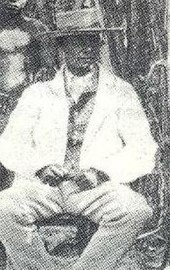Republic of Upingtonia
| Republiek Upingtonia Lijdensrust |
|||||
| Republic of Upingtonia | |||||
| 1885-1887 | |||||
|
|
|||||
| Official language |
Dutch Afrikaans German |
||||
| Capital | Grootfontein | ||||
| Form of government | republic | ||||
| Head of state , also head of government | George Diederik P. Prinsloo | ||||
| currency | South African pound | ||||
| independence | October 20, 1885 | ||||
| Time zone | UTC +2 | ||||
The Republic of Upingtonia , from 1886 Lijdensrust , was an independent Boer republic from October 20, 1885 to June 1887 in what is now the Namibian regions of Otjozondjupa and Omaheke around the Etosha pan . It was named after Thomas Upington and was incorporated into the German Colony of German South West Africa just two years after it was proclaimed .
history
Between 1874 and 1880 , farmers from the South African Transvaal emigrated as so-called Dorsland trekkers to the southern areas of what is now Angola . There were violent clashes with the Portuguese colonial power .
In 1885 William Worthington Jordan acquired 50,000 square kilometers of land from the King of the West Ondonga Kambonde kaMpingana . He paid for it with £ 300 , 25 rifles, a horse and a case of brandy. The country stretched approximately 170 kilometers from Okaukuejo in the west to Namutoni in the east. Kambonde hoped to gain support in the fight against the East Ondonga king Nehale lyaMpingana through the sale . At the same time, some Dorsland trekkers settled not far from Grootfontein on land that was given to them free of charge by Jordan. On October 20th they proclaimed the republic.
About 500 people lived in Upingtonia at that time. Contrary to expectations, support from the Cape Colony , with Thomas Upington as Prime Minister, was low. In 1886 the republic was renamed Lijdensrust. Georg Diederik Petrus Prinsloo was President. Due to the increase in attacks by the Herero , the republic submitted to the protection force for German South West Africa . Jordan was killed by Nehale lyaMpingana that same year, which led to the end of the republic.
Axel Wilhelm Eriksson was one of the well-known settlers .
Individual evidence
- ↑ a b Chris Marais, Julienne Du Toit: A Drink of Dry Land , 2006, p. 174.
- ↑ Ute Dieckmann: Hai || om in the Etosha Region: A History of Colonial Settlement, Ethnicity and Nature Conservation , Basler Afrika Bibliographien, 2007, p. 48.
- ↑ GPJ Trümpelmann: The Boer in Suid-wes Africa ., 1948
- ↑ Robbie John MacVicar Aitken: Exclusion and Inclusion: gradation of Whiteness and Socio-Economic Engineering in German South West Africa, 1884-1914 , 2007, p 191st
- ↑ Victor L. Tonchi, William A. Lindeke, John J. Grotpeter: Historical Dictionary of Namibia , 2012, p. 445.



